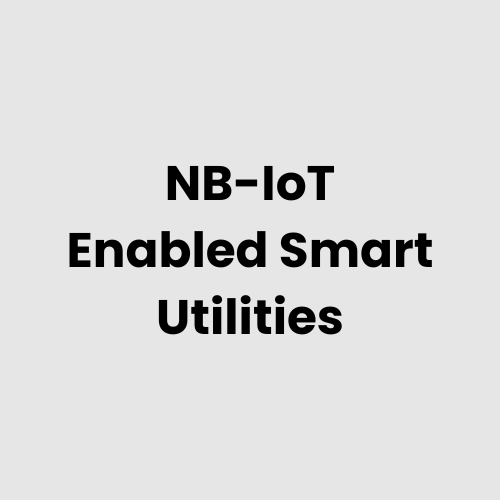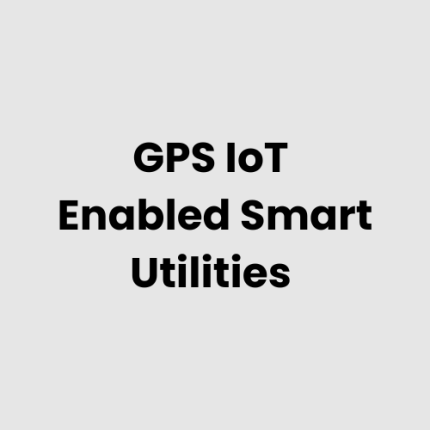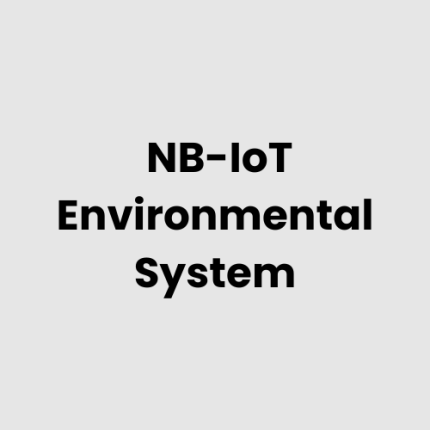Description
Technical Architecture
The NB-IoT Enabled Smart Utilities system is designed to optimize resource management and provide real-time monitoring across utilities like water, gas, electricity, and waste management. The system consists of multiple layers that work together seamlessly to provide efficient and scalable solutions. These layers include:
- IoT Sensors:
Sensors installed at key points in the utility infrastructure, such as water meters, gas sensors, or electrical meters, to capture real-time data on resource consumption, pressure, temperature, or other critical parameters. - NB-IoT Communication Network:
The sensors and devices communicate via NB-IoT technology, which ensures long-range, low-power, and reliable connectivity even in remote or challenging environments. - Data Aggregation Gateways:
Gateways aggregate data from the IoT sensors and devices, securely transmitting it to a central platform or cloud infrastructure. - Edge Devices (Optional):
For low-latency applications, edge devices can process sensor data locally, reducing the need for constant communication with the cloud and enabling faster decision-making. - Centralized Data Platform (Cloud or Local Server):
The platform receives, stores, and analyzes data from all sensors across the utility network, providing real-time monitoring, predictive analytics, and optimization features for utility managers. - Data Analytics & Visualization Tools:
These tools provide actionable insights, trend analysis, anomaly detection, and reporting to improve utility operations, forecast demand, and optimize resource distribution. - User Interface & Alerts:
Fleet operators, utility managers, and other stakeholders can access a user-friendly dashboard with customizable alerts and reporting features for effective decision-making.
List of Hardware for NB-IoT Enabled Smart Utilities
- IoT Sensors & Meters: Smart water meters, gas meters, energy meters, temperature sensors, pressure sensors, etc.
- NB-IoT Communication Modules: Modules that facilitate wireless data transmission from sensors to gateways or cloud.
- Gateways: Devices that aggregate and transmit sensor data to the central platform.
- Edge Devices (Optional): Local processing units to reduce data transfer and enable real-time decision-making.
- Control Units: Devices used to manage and configure sensors and actuators within the utility network.
- Power Supply Systems: Uninterrupted power supplies (UPS) and solar-powered systems for off-grid solutions.
- Data Platform Servers: Centralized servers for storing and processing utility data.
- User Devices: Devices like smartphones, tablets, or computers for real-time monitoring and system control.
Physical Placement Considerations of Hardware
- Sensors and Meters: Sensors should be strategically placed within the utility infrastructure. For example, water meters are placed in pipelines, energy meters are located at grid points, and gas sensors are installed in distribution lines. These sensors should be easy to maintain while ensuring minimal downtime.
- Gateways & Edge Devices: Gateways should be installed near the data sources (such as substations, water tanks, or gas pipelines) to ensure strong communication signals. Edge devices, if utilized, are placed within localized areas where real-time processing is required.
- Power Supply: Power solutions like solar panels or battery backup systems should be installed in remote locations where grid power is unavailable, ensuring continuous operation.
Hardware Architecture
The NB-IoT Enabled Smart Utilities system’s hardware architecture includes the following components:
- IoT Sensors: Placed throughout the utility infrastructure to monitor consumption and performance metrics.
- NB-IoT Communication Modules: Enable reliable long-distance communication for data transmission.
- Gateways: Collect and transmit data from various sensors to a central data platform.
- Edge Devices: Optional devices for local data processing to improve real-time decision-making.
- Centralized Data Platform: Stores and processes large volumes of utility data, providing insights and alerts to stakeholders.
- User Interface Devices: For operators to monitor and manage the system, receiving notifications and reports.
Deployment Considerations
When deploying the NB-IoT Enabled Smart Utilities system, consider the following:
- Scalability: The system should be scalable to handle various sizes of utility networks, from small districts to large cities.
- Network Coverage: Ensure reliable NB-IoT network coverage in the entire utility service area, including remote or rural locations.
- Security: Data transmitted across the network must be encrypted to ensure privacy and prevent unauthorized access.
- Power Management: Consider energy-efficient devices or solar-powered solutions for areas lacking stable power supplies.
- Integration with Existing Systems: The system must integrate seamlessly with existing utility infrastructure and software systems.
- Maintenance: Plan for routine maintenance and updates to hardware and software to ensure continuous system performance.
Relevant Industry Standards and Regulations
- ISO 50001 (Energy Management Systems)
- IEC 62056 (Electricity Metering)
- IEEE 802.15.4 (Low-Rate Wireless Personal Area Networks)
- EN 13757 (Metering for Water, Gas, Heat)
- 3GPP NB-IoT Specifications
- ISO 9001 (Quality Management Systems)
- GDPR (General Data Protection Regulation)
- FCC Part 15 (RF Devices)
- UL 508A (Industrial Control Panels)
- NIST Cybersecurity Framework
Local Server Version
For clients seeking control over data storage and processing, the NB-IoT Enabled Smart Utilities system can be deployed on a local server version. In this setup, all sensor data is processed and analyzed on-site rather than in the cloud, providing full control over data security and reducing reliance on external internet connections. This version is ideal for customers who require real-time, localized decision-making and enhanced privacy.
Cloud Integration and Data Management
GAO Tek’s NB-IoT Enabled Smart Utilities system also supports cloud integration, enabling seamless data transmission from sensors to a central cloud platform for advanced analytics and real-time monitoring. The system securely collects data from all utility meters and sensors, processes it, and stores it in the cloud. This integration allows users to access the data from anywhere, view detailed reports, set up automated alerts, and optimize operations with predictive analytics. The cloud infrastructure ensures that data is securely backed up, easily scalable, and accessible for analysis and reporting, offering a highly flexible and efficient solution for smart utility management.
GAO Case Studies of NB-IoT Enabled Smart Utilities
USA Case Studies
- New York, NY
A smart utility provider in New Yorkimplemented an NB-IoT solution for water consumption monitoring. The system enabled real-time data collection from smart meters, improving water usage management and enabling proactive leak detection, reducing water waste and lowering utility costs. - Los Angeles, CA
In Los Angeles, a utility company adopted NB-IoT technology for the monitoring of electricity consumption across the city. The system provided real-time data on energy usage, improving grid efficiency and enabling the company to optimize power distribution, reducing energy waste and improving service delivery. - Chicago, IL
A Chicagowater utility company implemented an NB-IoT-based system to monitor water quality across the city’s infrastructure. The system facilitated early detection of contaminants, improving safety standards and regulatory compliance while ensuring continuous access to clean water for residents. - Dallas, TX
A utility company in Dallasemployed NB-IoT to deploy smart meters for gas consumption monitoring. The real-time data from gas meters allowed for more accurate billing, optimized resource management, and reduced the incidence of leaks, leading to improved safety and operational efficiency. - Miami, FL
In Miami, an energy provider implemented an NB-IoT solution to monitor and optimize lighting systems across public spaces. The system enabled remote control of streetlights and improved energy efficiency, contributing to reduced operational costs and a greener environment. - Houston, TX
An NB-IoT-enabled smart water management system was introduced in Houstonto monitor the flow and pressure of water in real-time. This system allowed for rapid detection of leaks, improved maintenance schedules, and better resource management across the city’s water infrastructure. - San Francisco, CA
A San Franciscoutility company utilized NB-IoT for waste management monitoring. Sensors placed on waste containers reported real-time fill levels, enabling more efficient waste collection routes and reducing the carbon footprint of the city’s waste management services. - Atlanta, GA
A power utility in Atlantadeployed NB-IoT-based smart meters for electricity consumption tracking. The system provided granular data on energy usage patterns, enabling the utility to implement demand-side management strategies and optimize the distribution of electricity across the city. - Boston, MA
A Bostonutility service implemented an NB-IoT solution to monitor the quality of air and water within the city. The system provided continuous environmental data, which assisted in regulatory compliance and allowed the city to take prompt action in response to quality deviations. - Seattle, WA
In Seattle, a city utility adopted NB-IoT for monitoring and controlling the energy usage of public buildings. This technology enabled real-time tracking of power consumption, optimizing energy management and reducing waste across the city’s infrastructure. - Phoenix, AZ
A smart utility company in Phoenixdeployed NB-IoT technology for remote monitoring of gas pipeline systems. The system provided real-time data on gas flow and pressure, enabling quick detection of leaks and improving safety and efficiency in the delivery of natural gas. - Washington, D.C.
A utility company in Washington, D.C.implemented an NB-IoT system to monitor the city’s water systems. The system’s real-time data enabled the early identification of potential pipe failures and improved maintenance scheduling, reducing the risk of water disruptions. - Las Vegas, NV
A smart utility provider in Las Vegasutilized NB-IoT to monitor water distribution systems and improve the detection of leaks. The system provided actionable data on water usage patterns, reducing wastage and improving overall system efficiency. - Orlando, FL
A smart utility company in Orlandoimplemented an NB-IoT-based solution for remote monitoring of smart lighting systems in public parks. The system allowed for the automation of lighting schedules, reducing energy usage and improving the city’s energy efficiency. - Cleveland, OH
A utility company in Clevelandadopted NB-IoT to monitor electricity usage in the city’s industrial areas. This real-time monitoring enabled the identification of inefficiencies in energy consumption, improving operational efficiency and helping reduce the city’s energy expenditure. - Canada Case Studies
- Toronto, ON
A smart utility service in Torontoemployed NB-IoT technology to monitor the water quality of the city’s rivers and lakes. By integrating real-time environmental sensors, the system provided early alerts for any contamination, ensuring public health and regulatory compliance. - Vancouver, BC
In Vancouver, a utility provider implemented an NB-IoT-based smart grid system to monitor the energy usage of both residential and commercial buildings. The data provided insights into peak demand, enabling better energy distribution and efficient management of the electrical grid.
Navigation Menu for NB-IoT
Navigation Menu for IoT
- LORAWAN
- Wi-Fi HaLow
- Z-WAVE
- BLE & RFID
- NB-IOT
- CELLULAR IOT
- GPS IOT
- IOT SENSORS
- EDGE COMPUTING
- IOT SYSTEMS
Our products are in stock and can be shipped anywhere in the continental U.S. or Canada from our local warehouse. For any further information, please fill out this form or email us.
We are actively looking for partners who are like us located in the U.S. and Canada. For more information on partnering with GAO, please visit Partner with GAO Tek Inc. It lists various ways to partner with GAO, such as OEM Partnerships, Technology Integration, Distribution and Reselling Opportunities, Presenting at the Leading Event Tek Summit, Joint R&D Projects, Training and Consulting Services, Industry-Specific Collaborations, Research and Academic Partnerships.



